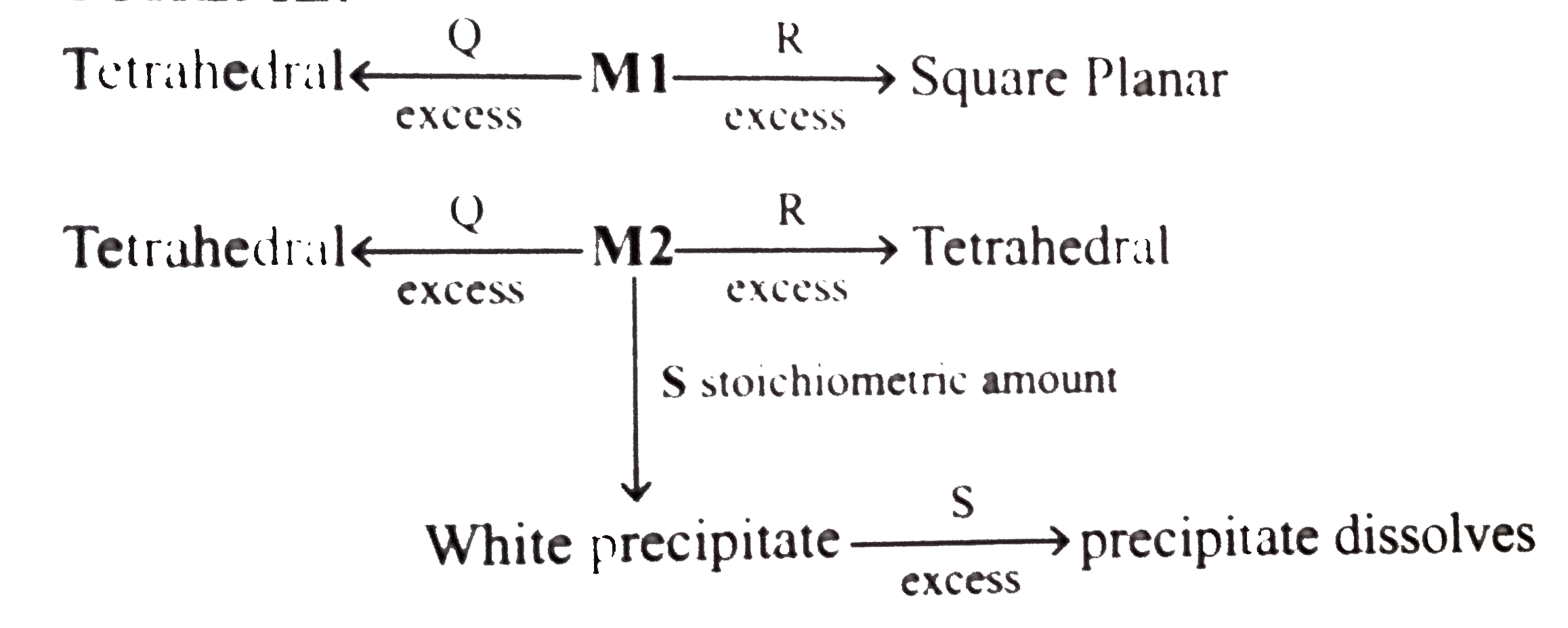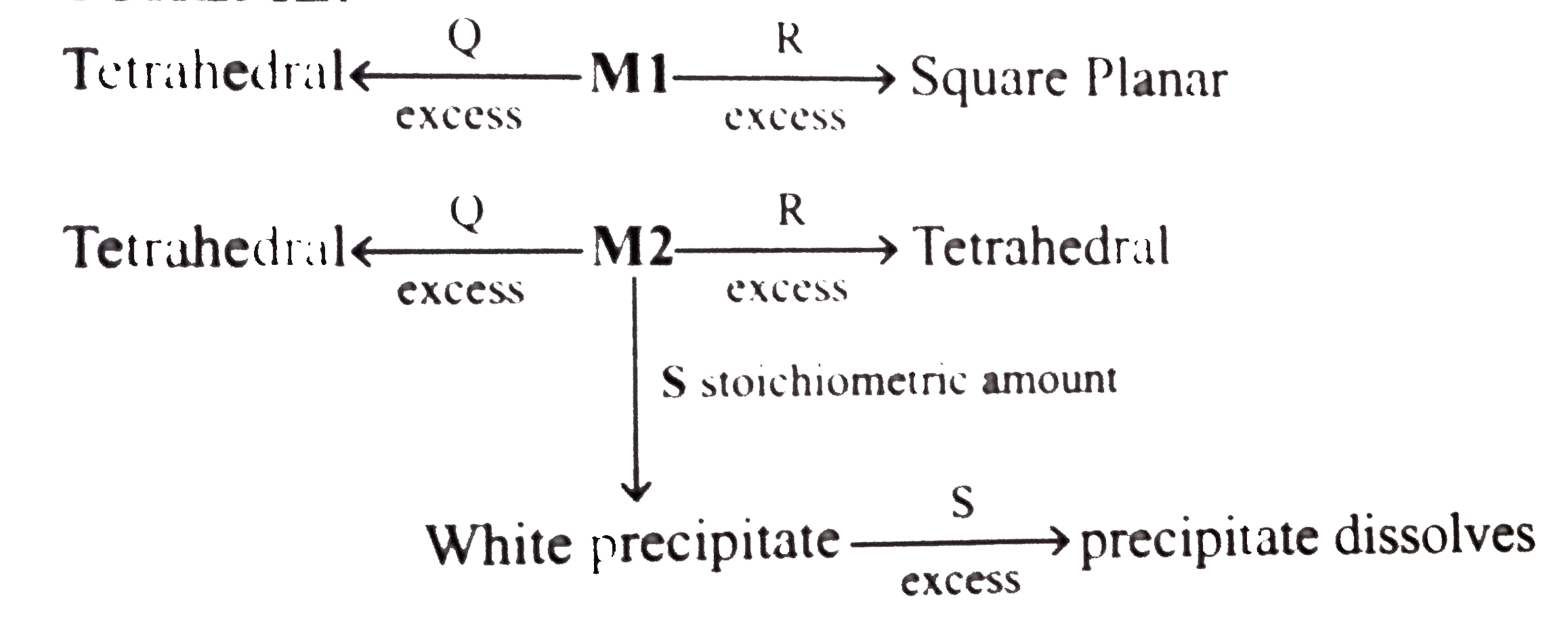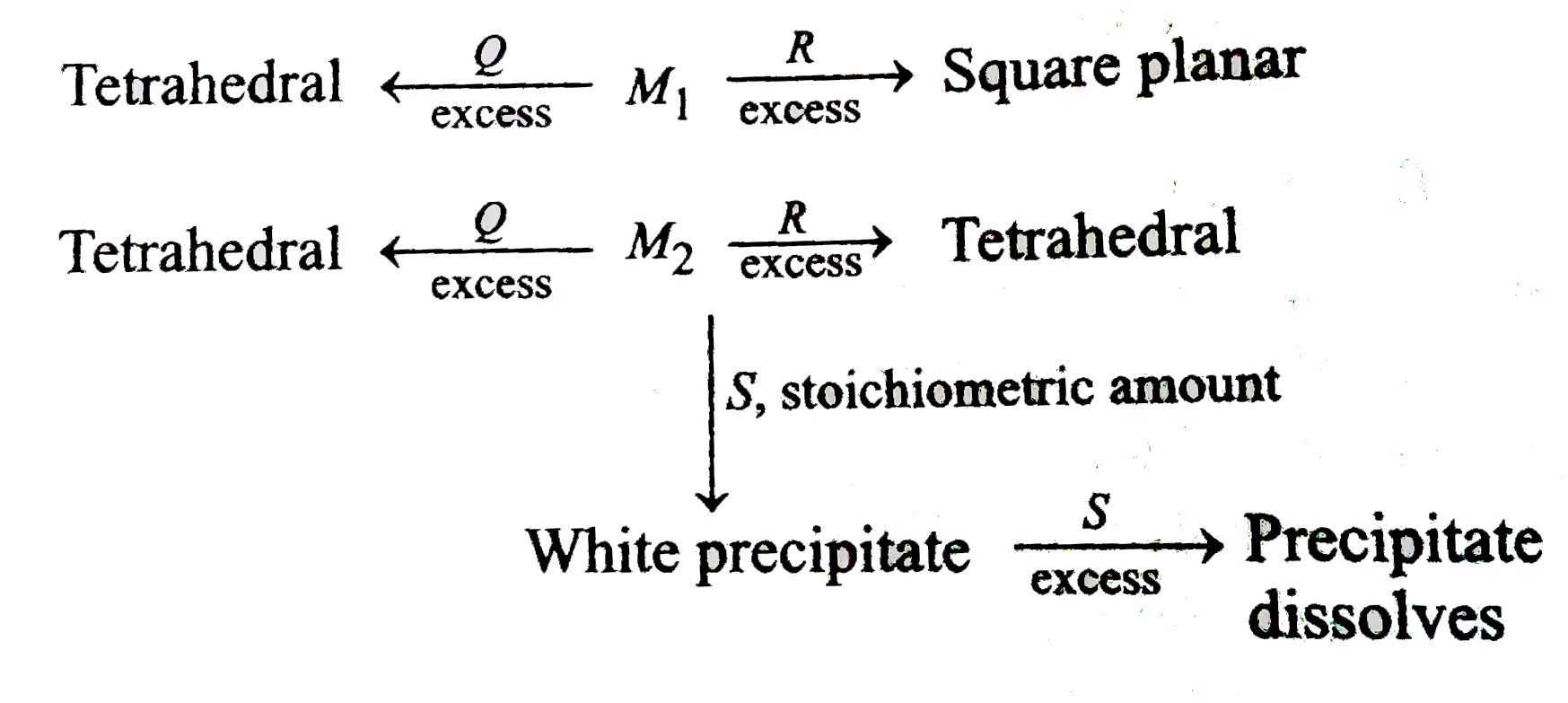An aqueous solution of metal ion M1 reacts separately with reagents Q and R in excess to gie tetrahedral and sqaure planar complexes, respectively. An aqueous solution of another metal ion M2 always forms tetrahedral complexes with these reagents. Aqueous solution of M2 on reaction with reagent S gives white precipitate which dissolves in excess of S. The reaction are summarised in the scheme given below
Scheme

Reagent S is
K4[Fe(CN)6]
Na2HPO4
K2CrO4
KOH
The correct Answer is:D
Topper's Solved these Questions
- QUALITATIVE ANALYSISBOOK - IIT-JEE PREVIOUS YEAR (CHEMISTRY)CHAPTER - QUALITATIVE ANALYSISEXERCISE - Fill in the blanks
1 Videos
- QUALITATIVE ANALYSISBOOK - IIT-JEE PREVIOUS YEAR (CHEMISTRY)CHAPTER - QUALITATIVE ANALYSISEXERCISE - True/False
1 Videos
- QUALITATIVE ANALYSISBOOK - IIT-JEE PREVIOUS YEAR (CHEMISTRY)CHAPTER - QUALITATIVE ANALYSISEXERCISE - Objective Question I
3 Videos
- PERIODIC CLASSIFICATION AND PERIODIC PROPERTIESBOOK - IIT-JEE PREVIOUS YEAR (CHEMISTRY)CHAPTER - PERIODIC CLASSIFICATION AND PERIODIC PROPERTIESEXERCISE - COMPREHENSION_TYPE
3 Videos
- S BLOCK ELEMENTSBOOK - IIT-JEE PREVIOUS YEAR (CHEMISTRY)CHAPTER - S BLOCK ELEMENTSEXERCISE - True/False
1 Videos
Similar Questions
An aqueous solution of metal ion MI reacts separately with reagents Q and R in excess to give tetrahedral and square planar complexes, respectively An aqueous solution of another metal ion M2 always forms tetrahedral complexs with theses reagents. Aqueous solution of M2 on reaction with reagent S gives white precipitate which dissolves in excess of S The reactions are summarised in the scheme given below: SCHEME :

What is M2
View SolutionAn aqueous solution of metal ion MI reacts separately with reagents Q and R in excess to give tetrahedral and square planar complexes, respectively An aqueous solution of another metal ion M2 always forms tetrahedral complexs with theses reagents. Aqueous solution of M2 on reaction with reagent S gives white precipitate which dissolves in excess of S The reactions are summarised in the scheme given below: SCHEME :

What is S?
View Solution
Knowledge Check
An aqueous solution of metal ion M1 reacts separately with reagents Q and R in excess to gie tetrahedral and sqaure planar complexes, respectively. An aqueous solution of another metal ion M2 always forms tetrahedral complexes with these reagents. Aqueous solution of M2 on reaction with reagent S gives white precipitate which dissolves in excess of S. The reaction are summarised in the scheme given below
Scheme

M1,Q and R, respectively areAZn2+,KCN and HClBNi2+,HCl and KCNCCd2+,KCN and HClDCo2+,HCl and KCNAn aqueous solution of metal ion MI reacts separately with reagents Q and R in excess to give tetrahedral and square planar complexes, respectively An aqueous solution of another metal ion M2 always forms tetrahedral complexs with theses reagents. Aqueous solution of M2 on reaction with reagent S gives white precipitate which dissolves in excess of S The reactions are summarised in the scheme given below: SCHEME :
 AZn2+,KCN and HCI .BNi2+,HCI and KCN .CCd2+,KCN and HCIDCo2+,HCI and KCN
AZn2+,KCN and HCI .BNi2+,HCI and KCN .CCd2+,KCN and HCIDCo2+,HCI and KCNAn aqueous solution of metal ion MI reacts separately with reagents Q and R in excess to give tetrahedral and square planar complexes, respectively An aqueous solution of another metal ion M2 always forms tetrahedral complexs with theses reagents. Aqueous solution of M2 on reaction with reagent S gives white precipitate which dissolves in excess of S The reactions are summarised in the scheme given below: SCHEME :
 AK4[Fe(CN)6]BNa2HPO4CK2CrO4DKOH
AK4[Fe(CN)6]BNa2HPO4CK2CrO4DKOH
In Aqueous solution, metal ion M1 reacts separately with reagents Q and R in excess to give tetrahedral and square planar complexes respectively. An aqueous solution of another metal ion M2 always froms tetrahedral complexes with these reagents. Aqueous solution of M2 on reaction with reagent S gives white precipitate which dissolves in excess of S. The reactions are summarized in the scheme given ahead

Reagent S is
View SolutionIn Aqueous solution, metal ion M1 reacts separately with reagents Q and R in excess to give tetrahedral and square planar complexes respectively. An aqueous solution of another metal ion M2 always froms tetrahedral complexes with these reagents. Aqueous solution of M2 on reaction with reagent S gives white precipitate which dissolves in excess of S. The reactions are summarized in the scheme given ahead

M1, Q and R respectively are
View SolutionAn aqueous solution of metal ion M1 reacts separately with reagents Q and R in excess to give tetrahedral and square planar complexes, respectively. An aqueous solution of anotherr metal ion M2 always forms tetrahedral complex with these reagents. Aqueous solution of M2 on reaction with reagent S gives white precipitate which dissolves in excess of S. The reactions are summarized in the scheme given ahead.
SCHEME:
Tetrahedral Q←−−excessM1R−−→excess Square planar
TetrahedralQ←−−excessM2R−−→excessTetrahedral ↓S.stoichiometric amount White pptS−−→excess.Precipitate dissolves
Reagent S is:
View SolutionAn aqueous solution of metal ion M1 reacts separately with reagents Q and R in excess to give tetrahedral and square planar complexes, respectively. An aqueous solution of anotherr metal ion M2 always forms tetrahedral complex with these reagents. Aqueous solution of M2 on reaction with reagent S gives white precipitate which dissolves in excess of S. The reactions are summarized in the scheme given ahead.
SCHEME:
Tetrahedral Q←−−excessM1R−−→excess Square planar
TetrahedralQ←−−excessM2R−−→excessTetrahedral ↓S.stoichiometric amount White pptS−−→excess.Precipitate dissolves
M1,Q and R, respectively are:
View SolutionAn aqueous solution containing S2− ions will not give:
View Solution
